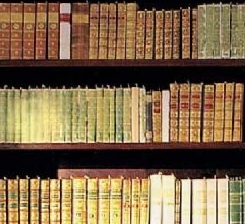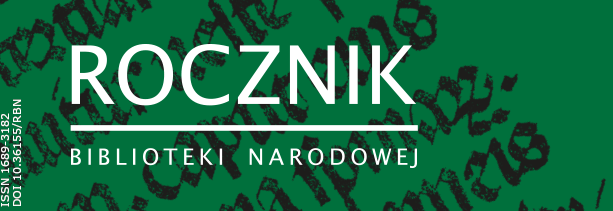NUMERY ARCHIWALNE

STRONA REDAKCYJNA, s. 4 / CREDITS, p. 4
STUDIA I MATERIAŁY / STUDIES AND MATERIALS
„Bazgrze iak Kura” czyli Fryderyk Chopin i powstańcy listopadowi w karykaturach Jozefa Szymona Kurowskiego ze zbiorow Biblioteki Narodowej, s. 5–45 / ≪Chicken scratches≫, or Frederic Chopin and the November insurgents in caricatures by Jozef Szymon Kurowski from the collections of the National Library, p. 5–45
The article discusses the previously unknown set of drawings by Joseph Simon Kurowski, a painter who specialized in portraying personalities of the Great Emigration. Discovered in storage at the Department of Manuscripts of the National Library, albums belonging to Zofia Ossolińska (née Chodkievicz) contain a collection of 24 drawings including satirical images of November insurgents (including Izydor Sobański, Aleksander and Edward Jełowicki, Anton Wodziński, General Józef Bem and General Henryk Dembinski, Edward Rottermund, Walenty Krosnowski, and Leonard Rettel). Created during the years 1835–1839, these works document their lives outside their country. The collection also includes three self-portraits of the artist, who was himself a participant in the Polish-Russian War of 1830–31. The most interesting items in the collection are, however, caricatures of Frederic Chopin. Based on comparative and stylistic analysis, we have managed to establish their proper attribution. The author of the humorous portraits was the pianist Józef Kurowski, and not, as previously assumed, Countess Ossolinska née Jablonowska. The article also discusses the original version, never before published and hitherto unknown to Chopin experts, of the caricature Chopin Toasting from 1837.
Elsneriana zachowane z przedwojennego zasobu Biblioteki Narodowej. Charakterystyka, losy i znaczenie kolekcji, s. 47–77 / Elsneriana preserved from the pre-war resources of the National Library. Characteristics, fate and significance of this collection, p. 47–77
One of the most important music collections in the National Library is a set of nineteenth-century handwritten manuscripts of Elsner’s works. The collection currently consists of 33 signature pieces. The transmitted manuscripts, consisting mainly of religious pieces and music for the stage, once belonged to the Library of the Directorate of State Art Collections and to the Music Library of the Government Theatres – both of which collections went to the National Library in the 1930s. In 1940, Elsneriana manuscripts were requisitioned by German musicologists and transported to Berlin to the library of the Nazi Party School, and then in 1942 to Kraków for an exhibition dedicated to Frederic Chopin. The collection survived, and in 1951 was returned to the National Library. This collection of manuscripts of works by Elsner has great historical value due to the large number of unique autographs and letters, especially among the manuscripts of operas that constitutes documentation of Elsner’s activities as a composer and music director of the National Theatre in Warsaw in the early nineteenth century.
Znaki Antychrysta. Miniatury starowierskiej Komentowanej Apokalipsy z kolekcji Biblioteki Narodowej, s. 79–96 / Aleksandra Sulikowska Signs of the Antichrist. Old Believer miniatures in the Komentowana Apokalipsa from the collections of the National Library, p. 79–96
The article is a discussion of the iconography of miniatures contained in the Komentowana Apokalipsa – originating from an early nineteenth-century manuscript, which probably arose in the environment of the Old Believers in Russia. This once belonged to the English collector Charles Butler (1821–1910), whose book has been in the collections of the National Library since 1985 and is one of the most interesting illustrated codices on the Apocalypse in Polish collections. The iconography found in the seventy-two miniatures are linked to ancient traditions of Ruthenian art, and also include many features uniquely characteristic of the culture of the Old Believers, forming one of the foundations of the eschatology and beliefs concerning the role that the Old Believers had to play when faced with the end of the world.
Dwie książki z dawnej biblioteki krola Zygmunta Augusta, s. 97–108 / Two books from the former library of King Sigismund Augustus, p. 97–108
Since the 1988 publication by A. Kawecka-Gryczowa of her monograph on the library of Sigismund Augustus, several more previously unknown masterpieces have been discovered. Two volumes unknown to Gryczowa appeared, among others, at auctions in Bydgoszcz and Warsaw. The article contains a detailed description of both of these volumes – including descriptions of their origin.
Listy Tadeusza i Wiesławy Rożewiczow do Henryka i Romany Voglerow. Wybor z lat 1958–2005, s. 109–126 / Letters from Tadeusz and Wiesława Rożewicz to Henryk and Romana Vogler. Selected from the years 1958–2005, p. 109–126
Presentation of a collection of letters from Tadeusz Rożewicz (1921–2014), poet, playwright, novelist, to Henryk Vogler (1911–2005), writer, literary critic, associated after 1958 with the Old Theatre and the Słowacki Theatre in Cracow, with a selection of correspondence stretching between 1958 and 2005. From the collections of the National Library, along with the Henryk Vogler archive, there were 185 letters and postcards (a total of approximately 250 manuscript cards) Różewicz sent from Gliwice and Wroclaw, as well as from Paris, Washington, Yalta, and Berlin. In the letters to Vogler the author is personal, candid, cordial, with a specific ironic sense of humor, sometimes snappy and even angry, and at times grumpy or depressed. He writes about his work, about literary circles, travel, always exhibiting an interest in life and plans of his friends.
Centralistyczna organizacja sieci bibliotek w Wojsku Polskim (1919–1936), s. 127–149 / Centralised organization of the network of libraries of the Polish Army (1919–1936), p. 127–149
Created November 15, 1919 by order of the Minister of Military Affairs, a centralised, three-tiered organisation of the military library network was adapted to the hierarchical levels of the army in terms of organisation and command. The leading institution in this was the Central Military Library (CBW), undertaking substantive supervision over the nine district libraries and working with the various Commands of the General Districts or DOGs (from 1921 Districts Commands of Corps or DOKs). By contrast, county libraries were subject to the acting officers of regiments (and larger equivalent branches of military establishments). Other libraries of military facilities included libraries of NCOs, soldiers and military schools, and from 1924 libraries within battalions. Subunits and outposts of the Border Protection Corps remained outside the centralised library network of the Polish Army.
Katalogowanie oparte na encjach, s. 151–200 / Cataloging based on entities, p. 151–200
The article presents the basis for changes in the scope of formal and subject matter descriptions. The main purpose of these changes is greater adherence of descriptions to FRBR and bringing the structure of bibliographic databases closer to relational databases. In this model, individual elements of bibliographic description are entities which are controlled instances of a common database of National Library Descriptors for both the formal and subject matter description of elements. An important element of the planned changes is to simplify the language of subject headings, including: elimination of positional grammar, revision of existing denotative-connotative concepts in information-retrieval
languages, the use of natural vocabulary, and an increase in the number and role of logical relationship descriptors in the database.Krajowa Statystyka Produkcji Wydawniczej (KSPW) dla książek. Geneza, organizacja i wykorzystanie do katalogowania pola 084 formatu MARC 21, s. 201–242 / The National Statistics for Publishing Production (KSPW) for books. Genesis, organisation and use of the catalogue field 084 in the MARC 21 format, p. 201–242
The article presents the principles of the new categorisation of books, which the National Library introduced in 2013 to answer to the needs of publication statistics. In developing the new categories for books, it was the purposes that different readers might primarily use them for that were taken into account, rather than the type of reader for which they were intended. The new categorization is more complex compared to the one previously used – the set of categories describing belles-lettres is particularly enriched. Various classification systems
currently used in Poland and in the world of books – both in libraries and in publishing and bookselling – were used as inspiration. The article presents the exact characteristics of all twenty-two categories that make up this system of categorisation.Informatyka w służbie filologii łacińskiej i historii, s. 243–265 / Tomasz Jasiński Science in the service of Latin philology and history, p. 243–265
At the Kórnik Library of the Polish Academy of Sciences, a team of historians, classical philologists, librarians and computer scientists have undertaken (2012-2016) a grant project entitled A new generation of computer programs to analyze Latin narrative and documentary texts together with an electronic database of texts and a database of Polish state officials of the twelfth through the eighteenth centuries. This program will be the world’s first research tool containing a database of the entire Latin vocabulary with all the grammatical and chronemic values. It will be a multifunctional and generally accessible program to examine Latin poetry according to vowel length and rhythm, as well as to detect chronemic flow, mixture (eg. mixtus) and accent.
RECENZJE / REVIEWS
Ks. Tomasz Moskal, Książka w kulturze sandomierskiego środowiska kolegiackiego do 1818 roku, Lublin 2013, s. 266–274 / Ks. Tomasz Moskal, Książka w kulturze sandomierskiego środowiska kolegiackiego do 1818 roku, Lublin 2013, p. 266–274
Rękopisy supraskie w zbiorach krajowych i obcych, oprac. Antoni Mironowicz; Katalog rękopisow supraskich, oprac. Antoni Mironowicz, Nadieżda Morozowa, Marina Czistiakowa, Elżbieta Kierejczuk, Eugenia Mironowicz, Nikołaj Nikołajew, Białystok 2014, s. 275–280 / Rękopisy supraskie w zbiorach krajowych i obcych, oprac. Antoni Mironowicz; Katalog rękopisow supraskich, oprac. Antoni Mironowicz, Nadieżda Morozowa, Marina Czistiakowa, Elżbieta Kierejczuk, Eugenia Mironowicz, Nikołaj Nikołajew, Białystok 2014, p. 275–280

